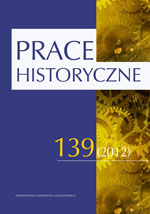Akta katyńskie doktora Robla. Powstanie i losy tzw. Archiwum Robla oraz sylwetka jego twórcy
Doctor Robel’s Katyn Files. The Creation and History of the So-called Robel Archive and the Silhouette of Its Founder
Author(s): Tomasz DziedzicSubject(s): History
Published by: Wydawnictwo Uniwersytetu Jagiellońskiego
Keywords: Robel’s Katyn Files; Katyn; Polish officers; Polish Red Cross; Jan Zygmunt Robel; Robel Archive; NKWD (Soviet Intelligence Service)
Summary/Abstract: In the first half of 1943 an exhumation of the bodies of Polish officers was carried out in Katyn. The objects found by the bodies and particularly those which could have some significance from the point of view of establishing the identity of the victims, such as all kinds of documents, were sent to Krakow. Subsequently at the request of the Polish Red Cross, a team of Polish experts under the supervision of Dr. Jan Zygmunt Robel carried out an examination of the so called Katyń legacy in the Chemical Branch of the local State Institute of Forensic Medicine and Criminology. Apart from the officially commissioned task aimed at identifying the victims, the team of experts from the Chemical Branch of the Institute also examined clandestinely the circumstances of death of the Polish offi cers. In the effect of these analyses, there arose a so called Robel Archive – a collection of documents containing a detailed description of the objects exhumed from the Katyn graves as well as copies of the documents found by the bodies, including all kinds of notes and memoirs. The investigation work carried out by the Polish experts was suddenly interrupted in the summer of 1944 when the Katyn legacy was transported by the Germans in the western direction and probably destroyed. However the Robel Archive avoided a similar plight. Although one of its copies fell into Soviet hands, Dr. Robel managed to successfully hide two other copies, in spite of his arrest and interrogation by the NKWD (Soviet Intelligence Service). After having been found in 1991, the materials constitute a valuable though so far little insufficiently researched historical source.
Journal: Prace Historyczne
- Issue Year: 139/2012
- Issue No: 1
- Page Range: 125-147
- Page Count: 23
- Language: Polish

